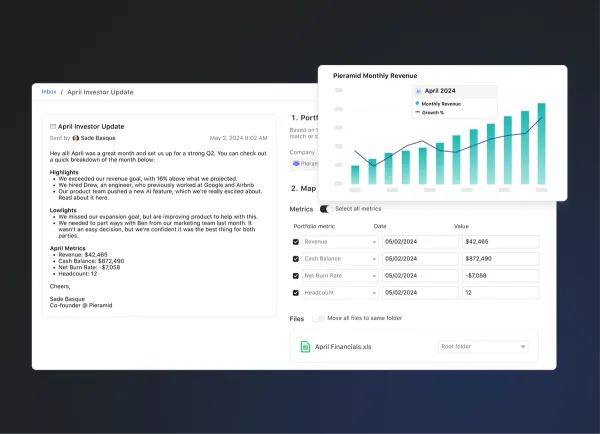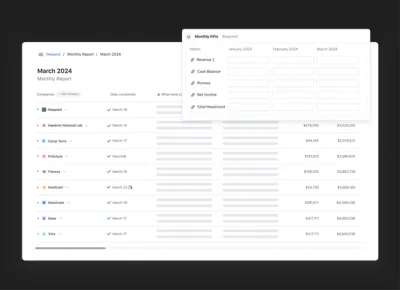
VC Audit Definition
Before we address best practices it's important to define what the VC audit entails. A VC audit is when a Venture Capital firm enlists a third-party auditor to evaluate its financial compliance. The auditor will review key fund documentation alongside recent portfolio performance to ensure the firm's valuations are accurate.
Which VC Firms Require an Audit
On August 23, 2023 the SEC approved new rules for private fund advisers. The changes will require all SEC-registered private fund advisers to have an annual audit regardless of size. Prior to this change, some funds were considered exempt but it was still common for VCs to conduct an audit to help better position the firm for future fundraising from potential LPs who want to see audited financials.
Purpose of an Audit
The purpose of a VC audit can be summarized in three parts:
- Ensure the fund’s General Partner(s) are operating in accordance with the fund’s LPA and that the financials reflect compliance
- Confirm the fund’s valuations of portfolio companies and the fund’s ownership position in them
- Give LPs confidence that a neutral third party validates the fund’s financial statements and assessment of its own success
General VC Audit Timeline
Audits are typically conducted on an annual basis using end-of-year figures. The audit process typically starts in the final month of the calendar year and wraps up during the first quarter of the calendar year.
Although audits only happen once per year, it’s important to maintain clean records of things like company valuations, company financial metrics, fund expenses, capital calls, and other transactions throughout the year. Continual hygiene of fund records translates into a smoother audit process at the end of the year.
Here's a general timeline for the VC audit process:
Q1 - Q4 - Collect portfolio company KPI's and monitor valuation changes
Q4 - Establish audit timeline with fund admin and auditor. Additionally, the pre-audit process should kick off so auditors have a chance to understand a firm's operations.
Q1 - In January, firms should be doing year-end valuations and closing their books. During this month fund managers should also be reviewing the books before sending the final figures to an auditor. During January or February, the audit process officially begins.
Q2 - April 30 is the official audit deadline but extensions to the deadline can be requested.
For more audit best practices check this webinar co-hosted with Visible and Weaver -- How to Prepare for Your Fund Audit.
How to Prepare for a VC Audit
Choosing an Audit Firm
This is an important step in setting yourself up for audit success. When choosing an auditor it's important to choose a service provider who specializes and understands the nuances of Venture Capital. Otherwise, you risk spending time during the audit process having to teach your auditor about your industry. You can do this by checking out their website and if they have published resources on Venture Capital then this is a great indication that they have knowledge of your industry. You should also ask the team you'll be directly working with whether they have experience in the VC industry.
If you're an emerging manager and expect to need hand-holding during the audit process, make sure you choose an auditor who is open for ad-hoc questions. During the diligence process, you should ask the auditor about their policy for asking questions and if there is an additional charge.
Related Resource: Five Simple Steps Key Venture Capital Staff Can Take to Support a Successful Audit
Establishing a Valuation Policy
It's a great idea to establish a valuation policy before your first audit. This policy outlines how your firm will justify its portfolio company valuations under different circumstances.
Related resource: Establishing a Valuation Policy
Preparing the Required Documents and Information
While not a comprehensive list, here are some of the items that funds will likely be asked to provide to auditors:
- Limited Partnership Agreement
- Financial statements
- Fully signed deal documentation
- Invoices to prove the firm is charging LPs for permitted expenses
- Transaction records (capital calls, distributions, bank balances)
- Updated ownership positions in each company (cap tables)
- Proof of valuation calculations/policies
- Portfolio company contacts (name and email address)
- Portfolio company financials (year-end)
- Portfolio company financing documents from most recent rounds
- Portfolio company balance sheets
- Portfolio company revenue reports
- An established valuation policy
Pro Tip: Ensure you are sending your auditor the fully executed (signed) version of the documents. Doing this will help cut down time during the audit process and help firms save money.
Hustle Fund reminds investors in this article Fund Audit 101 – Everything You Need To Know that it’s the job of the VC to provide this information to auditors and that the required documentation can change from year to year. It can be helpful to ask your auditor to provide quarterly updates about what they will be asking for during the annual audit.
Related Resource: 8 Questions to Ask Before Auditing Your First Venture Capital Fund
Monitoring Portfolio Companies Using Visible
One of the most time-consuming parts of the audit process is the back and forth that can occur when auditors need more evidence on how the VC firm arrived at company valuation figures. To justify valuations, it's important to have key information from your portfolio companies at the ready. Check out the list below to see what you need to have on file.
Portfolio monitoring audit checklist:
- Revenue budget vs actual
- Cash on hand
- Burn rate
- Company performance vs business plan
- Details about the last round of financing
Visible equips investors with a founder-friendly way to ask for key audit information from portfolio companies. Visible's Request feature allows for any custom metric, qualitative question, files, properties, and more. This streamlined approach to data collection helps VC firms keep up-to-date and accurate records about their portfolio companies throughout the year — leading to a smoother audit process.
Check out an Example Request in Visible.
More than 400+ VCs use Visible to streamline their portfolio monitoring and reporting.




